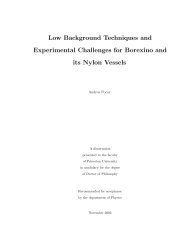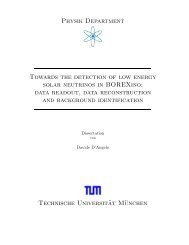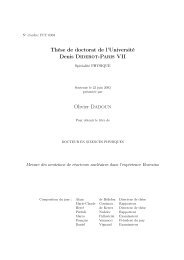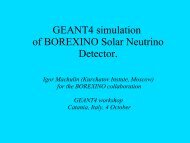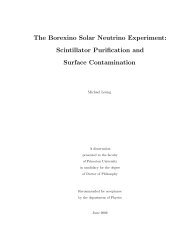Development of a Liquid Scintillator and of Data ... - Borexino - Infn
Development of a Liquid Scintillator and of Data ... - Borexino - Infn
Development of a Liquid Scintillator and of Data ... - Borexino - Infn
Create successful ePaper yourself
Turn your PDF publications into a flip-book with our unique Google optimized e-Paper software.
5.1 Pulse Shape Discrimination in <strong>Liquid</strong> <strong>Scintillator</strong><br />
track are quenched by competing reactions before they have an opportunity to transfer their<br />
energy to the fluors which will emit the photons. Hence, an alpha particle will produce, on average<br />
the same number <strong>of</strong> photons as an electron with about one tenth <strong>of</strong> its energy. Quenching<br />
results in a non-linear relation between the deposited energy <strong>and</strong> the emitted scintillation light.<br />
This relation can be parametrized as<br />
Ä<br />
Ü <br />
<br />
Ü<br />
<br />
Ü<br />
(Birk’s law)<br />
is a characteristic magnitude <strong>of</strong> the quenching (in Birks model, is the fraction <strong>of</strong><br />
Ü<br />
’damaged’ molecules along the particle track; is the fraction <strong>of</strong> these molecules which cause<br />
quenching). The alpha quenching in the scintillator mixtures tested in the CTF has been measured<br />
on laboratory samples for various alpha energies (see table 5.1). The pulse height <strong>of</strong><br />
the alpha particles was compared to the pulse height <strong>of</strong> betas with known energies (Compton<br />
scattering <strong>of</strong> gamma rays). The ratio <strong>of</strong> the alpha energy to the ‘beta -equivalent’, measured<br />
energy is defined as the quenching factor. From these measurements, the value <strong>of</strong> can be<br />
calculated:<br />
È ÈÈÇ Ð ¦ ¡<br />
È ÌÈ Ð ×ÅË ÑÐ ¦ ¡<br />
ÑÅÎ<br />
ÑÅÎ<br />
The relative intensity <strong>of</strong> the fast <strong>and</strong> the slow scintillation components also depends on the<br />
energy loss per unit path length, since the slow component is less affected by quenching. Thus,<br />
the relative intensity <strong>of</strong> the slow component is larger for alpha particles than for electrons,<br />
thus allowing to discriminate between the two types <strong>of</strong> radiation on the basis <strong>of</strong> the decay time<br />
distribution.<br />
Element «-energy (MeV) measured energy (keV) quenching factor<br />
È ÈÈÇ Ð<br />
Rn 5.49 ¦ ¦ <br />
Po 6.00 ¦ ¦ <br />
Po 7.69 ¦ ¦ <br />
Po 5.30 ¦ ¦ <br />
È ÌÈ Ð ×ÅË ÑÐ<br />
Rn 5.49 ¦ ¦ <br />
Po 6.00 ¦ ¦ <br />
Po 7.69 ¦ ¦ <br />
Po 5.30 ¦ ¦ <br />
Table 5.1: Quenching factors for alpha particles with different energies for scintillator mixtures<br />
based on PXE <strong>and</strong> PC. Measured on small samples [Nef96].<br />
63



